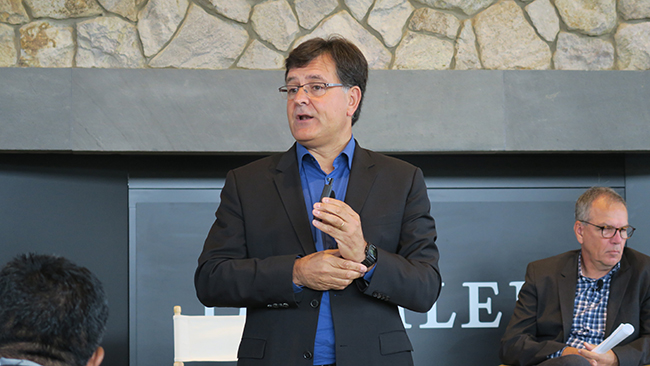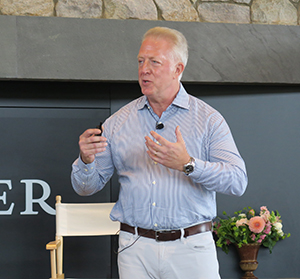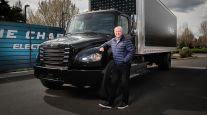Managing Editor, Features and Multimedia
DTNA Cites Increase in Active Safety Adoption

[Stay on top of transportation news: Get TTNews in your inbox.]
YOUNTVILLE, Calif. — Executives at Daimler Trucks North America cited an increase in customer take rates for active safety technology and provided updates on the manufacturer’s initiatives to enhance maintenance and customer service during a press event here Aug. 20.
Richard Howard, DTNA’s senior vice president of sales and marketing, said seven out of 10 of its new trucks are spec’ed with its proprietary Detroit Assurance active safety technology.
The latest version of that camera- and radar-based safety suite, Detroit Assurance 5.0, will add automated steering functionality as an option.
The new Active Lane Assist feature will include two active steering capabilities: lane keep assist, which automatically keeps the truck centered in its lane while adaptive cruise control is enabled, and lane departure protection, which nudges the truck back into its lane when it starts to drift without a turn signal.

DTNA’s Howard says active safety technology has become a higher priority for fleets. (Seth Clevenger/Transport Topics)
These advances represent SAE Level 2 automated driving, in which the system automates both forward and lateral control of the vehicle but still requires the driver to remain engaged at all times.
Detroit Assurance 5.0 was set to enter production in September, but Active Lane Assist will not become widely available until early 2020.
Howard said it is still early to project adoption rates for the new lateral control features, but cited “great interest” from fleet customers.
“The jury’s out, but I will say that interest is super high,” he said.
Much like other emerging technologies, some fleets will want to add automated steering control to all of their vehicles, while others will choose to test a few units and get driver feedback, said Kelly Gedert, director of product marketing for Freightliner and Detroit.

In our third episode of RoadSigns, Season Three, we ask: Is Predictive Maintenance the Next Big Leap for Fleet Efficiency? Hear a snippet from host Seth Clevenger, above, and get the full program by going to RoadSigns.TTNews.com.
“We’ve noticed that over the past five or six years, the driver has become a really important part of the story in terms of what our customers are spec’ing,” she said.
While fuel efficiency has long been a top focus for truck buyers, demand for safety technology has been rising as well, Howard said.
“Active safety systems are a higher priority for our customers’ businesses today than ever before,” he said, adding that DTNA’s integrated safety technology differentiates it from other systems on the market.
Customers also have continued to shift toward DTNA’s proprietary powertrain options, with 19 of 20 buyers now opting for a Detroit engine and 17 of 20 choosing a Detroit transmission, Howard said.
David Carson, president of Western Star Trucks, said the vocational segment also has seen an increase in uptake for safety technology.
In the past, vocational truck operations often weren’t willing to pay for those safety features, or felt they didn’t need them because their trucks spend much of their time off-road, but that mindset is changing.
Carson attributed that trend in part to consolidation in a number of industry sectors, creating larger companies that are focusing more closely on risk management.
“They want to ensure they have the best technology available on those vocational trucks,” he said.
Meanwhile, DTNA remains committed to providing a turnaround time of 24 hours or less for truck maintenance, said Stefan Kurschner, senior vice president of aftermarket.
To deliver on that promise, DTNA is leveraging its dealer network, its longtime service partnership with TravelCenters of America and Petro Stopping Centers, its Alliance Truck Parts brand and the availability of dedicated delivery services to 90% of U.S. service locations.
The truck maker also has been investing in technology to provide express check-in at dealerships and a service tracker to give the customer greater visibility into the truck’s status.
DTNA also recently announced the formation of its Customer Experience, or CX, organization.

Romanaggi, DTNA's new CX officer, outlines his thoughts. (Seth Clevenger/Transport Topics)
“We’ve put a lot of horsepower behind the idea of customer experience, to move it from a buzzword to a real-life experience,” Kurschner said.
The CX Organization, led by Paul Romanaggi, has been tasked with solving customers’ immediate needs faster and more effectively, while finding opportunities to improve the company’s processes of understanding customers’ needs for the future.
“We want to identify what we can be doing differently, and make ourselves even better as we move forward,” said Romanaggi, a 34-year veteran of DTNA.
As part of the initiative, DTNA has created a dedicated team of field staff responsible for supporting the manufacturer’s top 100 fleet customers.




